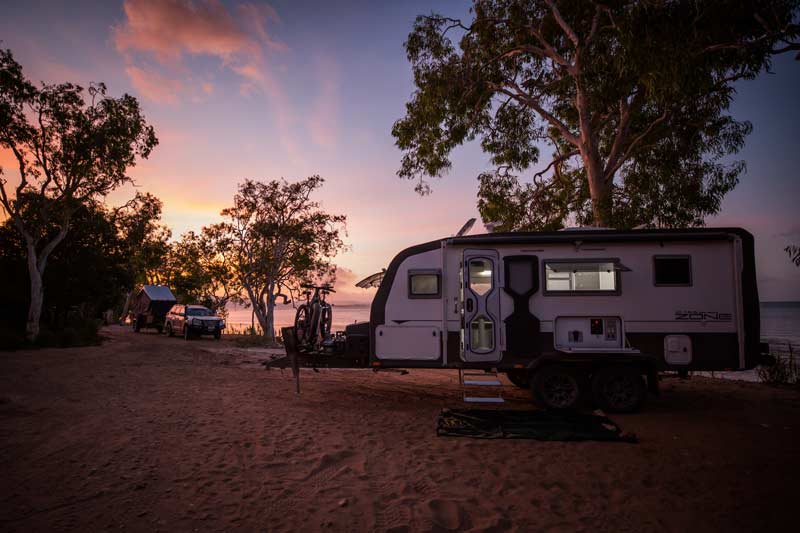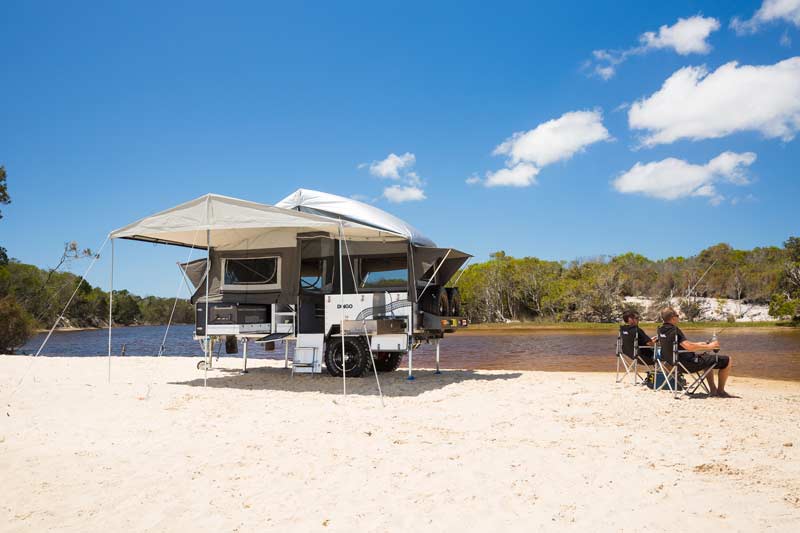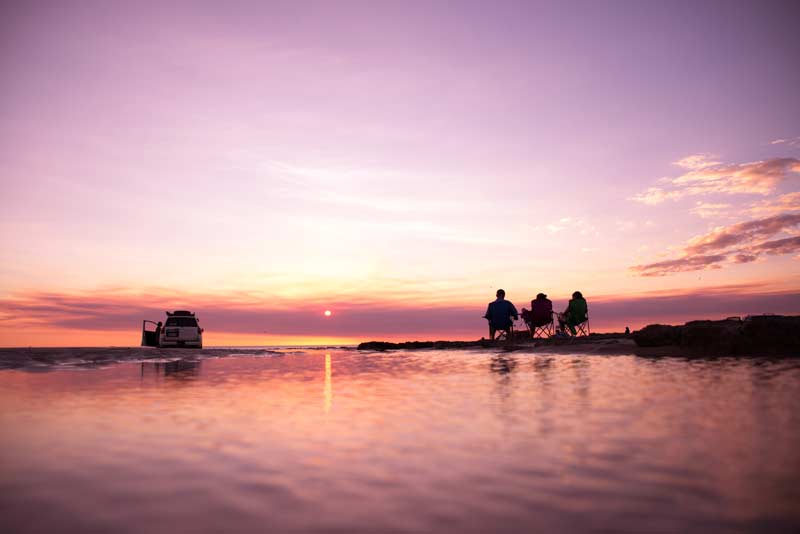Remote beach camping
Not much can beat drifting off to sleep under a million-star sky with the sound of waves lapping the nearby beach, and the warm sea breeze gently drifting through the canvas. Camping on a peaceful, remote beach, miles from civilisation, is one of life’s simple pleasures and we’ve hit the road to bring you a few of our favourites.
ELIM BEACH, QLD
Also known as ‘Eddie’s Beach’ or ‘Eddie’s Camp’, this remote Queensland beach camp is named for its caretaker and traditional owner Eddie Deemal, who has gained cult-like status among those who know him.
If you’re heading up to the Cape, you’ll find Elim Beach about 100km north of Cooktown down a series of sealed and unsealed roads suitable for most vehicles and RVs with reasonable ground clearance. But you’ll need to buy a camping permit ($10) in Hope Vale before you leave civilisation.
A rickety old sign is the only hint you’ve arrived and the campsite is huge and basic – this is not five-star glamping. But you can set up wherever you like, and as close to the beach as you want – but those with heavy vans or rigs might want to stick to firmer ground a little higher up.
DAMPIER PENINSULA, WA
The popularity (and crowds) of Broome and Cape Leveque reflect their status as jewels in the crown of WA’s Kimberley region but, if you’re looking for a remote beach camp that’s a little more peaceful, keep heading north to the quieter beach camps of the Dampier Peninsula.
The sandy, corrugated ‘road’ up there has the reputation of being one of the Kimberley’s worst roads, which helps keeps the crowds away. Our pick of the bunch is James Price Point, where the outback meets the sea.
CAPE MELVILLE, QLD
If you truly love to get off the beaten track, Cape York Peninsula’s Cape Melville is the place for you. Isolated, remote and difficult to get to, you won’t find yourself stuck in traffic on the way here! It’s a wild, beautiful environment with a unique landscape of impressive granite boulders, sandstone escarpments, rocky headlands, inland dunes and the sandy beaches of Bathurst Bay.
There are a couple of camping areas along the beach towards Cape Melville but they are not suitable for trailers, caravans, campervans or buses, so it’s 4WD and tent camping only. All camping must be booked through Queensland’s Department of National Parks, Sport and Racing prior to arrival.
NHULUNBUY, NT
You’d be hard pressed to find a more remote beach camp than at Nhulunbuy in the Northern Territory. This region encompasses 91,000 square kilometres of unspoiled wilderness and is home to just 4000 people. It is an epicentre of Australian Indigenous culture and an absolute outdoor lover’s paradise. All visitors require a free tourist permit, which can be acquired through the Northern Land Council, and beach camping is available. However, the drive in along the Central Arnhem Road can be treacherous and is not suitable for caravans or camper trailers, so this is 4WD-only territory.
BEACH CAMPING TIPS
Keep it light
Towing a camper trailer or caravan along a beautiful beach might seem like a laugh but you won’t think it’s as funny when you’re axle-deep in the soft stuff because you packed everything including the kitchen sink. Don’t overload your 4WD and RV – the more gear you pack, the harder your vehicle has to work on the sand and the more likely you are to get bogged.
Carry recovery aids
Your first resort, if you do find yourself ‘waiting for a mate’ and unable to drive out, should be a set of traction aids like MaxTrax or similar. These will often suffice on their own, or they can be used to aid a snatch or winch recovery.
Check the tides
Before you head out on to the beach, take the time to do some research. Find out what the tides are doing and when the safest time to drive on the beach is. Remember, high tide on some stretches can consume the entire beach, so you don’t want to get bogged while the tide’s on its way in. If you don’t have internet access or can’t find the information you need online, call ahead to the local shop, servo or pub to get a few pointers from the locals.
Setting up camp on sand
Camping on sand can can often be more trouble than it’s worth. If you’re travelling with a large RV, consider setting up back from the beach on harder ground. But if you’re dead-set certain you want to feel the sand beneath your toes, chuck a few planks of hardwood under your RV tyres and jockey wheel to keep it level. And, remember, ordinary pegs won’t cut it for holding down your tent or awning. Sand pegs are the way to go, and the bigger they are the better the chance of them staying put. If that doesn’t work, break out the sandbags!
WHAT GEAR DO I NEED?
You’ve put in the hard yards to trek out to your peaceful, remote beach camp and you want to make the most of it. There’s not much worse than having to cut your long-awaited camping trip short due a shortage of the essentials like power and water.
Water supply
If you’re travelling with a caravan or camper trailer, chances are, you have an inbuilt water tank or tanks to hold fresh drinking water and, sometimes, even grey water discharge. But the warm weather which is usually associated with perfect beach camping may see you run through your water supplies quicker than anticipated. The easiest way to keep an eye on your water usage and the amount left in your tanks is with a water level indicator, like BMPRO’s Dipper, and a digital monitor, such as the Drifter.
Power capacity
When you’re parked up enjoying beach camping paradise, the last thing you want to worry about is keeping your batteries charged. That’s where a power management system like BMPRO’s BatteryPlus range will do all the hard work for you. Warm beach weather is the perfect time to hook up your solar panels and harness the sun’s rays in order to top up your batteries and a PMS like the BatteryPlus35SR with inbuilt solar regulator will manage the whole process for you.
Like this Post? Share it!






